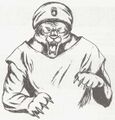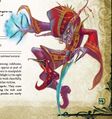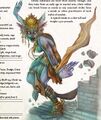Rakshasa: Difference between revisions
1d4chan>Nubnuber |
imported>Administrator m 29 revisions imported |
||
| (11 intermediate revisions by 6 users not shown) | |||
| Line 1: | Line 1: | ||
[[File:Yakshagana rakshasa.jpg|thumb|right|300px|A [[wikipedia:yakshagana|yakshagana]] performer dressed as a rakshasa]] | [[File:Yakshagana rakshasa.jpg|thumb|right|300px|A [[wikipedia:yakshagana|yakshagana]] performer dressed as a rakshasa]] | ||
The '''Rakshasa''' is a typically evil spirit from India, originally part of the Hindu traditions, before being assimilated into Indian Buddhism. The term (one that is both easily misspelled and hard to pronounce) is technically reserved for the males of the species, with females being called Rakshasi. Both genders are generally depicted as malevolent, powerfully magical creatures with bestial traits, a knack for shapeshifting, and a voracious appetite for human flesh - not always, however; as in many other cultures, Indians do not believe that all Rakshasa are all evil, and there are stories of benevolent or redeemed rakshasas. | The '''Rakshasa''' is a typically evil spirit from India, originally part of the Hindu traditions, before being assimilated into Indian Buddhism. The term (one that is both easily misspelled and hard to pronounce) is technically reserved for the males of the species, with females being called Rakshasi. Both genders are generally depicted as malevolent, powerfully magical creatures with bestial traits, a knack for shapeshifting, and a voracious appetite for human flesh - not always, however; as in many other cultures, Indians do not believe that all Rakshasa are all evil, and there are stories of benevolent or redeemed rakshasas. | ||
| Line 5: | Line 4: | ||
==Relevance to /tg/== | ==Relevance to /tg/== | ||
[[File:Rakshasa 4e.png|left|300px]] | [[File:Rakshasa 4e.png|left|300px]] | ||
The | The Rakshasa is most notable in /tg/ culture as an addition to [[Dungeons & Dragons]], way back in The Strategic Review #5, December 1975, before reappearing in the 1976 Supplement IV: Gods, Demi-Gods & Heroes. When [[Advanced Dungeons & Dragons]] came out, they were part of the main Monster Manual, a position they have retained in every single edition since. | ||
They are not [[rakasta]] although the two look similar. | |||
D&D's Rakshasas are master shapeshifters and illusionists. Categorized as one of the "fiendish" races, they are selfish, arrogant, hedonistic bastards; in their true form they resemble humans with the heads and tails of tigers (although background fluff occasionally gives them alternate heads, like apes, wolves or mantises) and "reversed" hands. Whether this means they are upside down or the wrong way around (i.e. so the left hand is on the right wrist, and vice versa) varies with the depiction. | D&D's Rakshasas are master shapeshifters and illusionists. Categorized as one of the "fiendish" races, they are selfish, arrogant, hedonistic bastards; in their true form they resemble humans with the heads and tails of tigers (although background fluff occasionally gives them alternate heads, like apes, wolves or mantises) and "reversed" hands. Whether this means they are upside down or the wrong way around (i.e. so the left hand is on the right wrist, and vice versa) varies with the depiction. | ||
| Line 13: | Line 14: | ||
Beyond this, D&D Rakshasa haven't varied much from this model. A notable exception is the [[Eberron]] setting, where they are some of the most powerful remaining servitors of the Demon Lords of Khyber, and a conspiracy of the most powerful rakshasa rajahs, the Lords of Dust, is one of the prime evil organizations and high-level threats in the game. One side effect this has to the world is that the popular image of a fiend in the minds of the average person of Eberron isn't horns, red skin, and cloven hoofs, it's (cat) '''[[Furry|furries]]''' that are considered the fiend sterotype. This actually makes things better for a "standard" [[Tiefling]], though cat [[Shifter]]s are screwed. | Beyond this, D&D Rakshasa haven't varied much from this model. A notable exception is the [[Eberron]] setting, where they are some of the most powerful remaining servitors of the Demon Lords of Khyber, and a conspiracy of the most powerful rakshasa rajahs, the Lords of Dust, is one of the prime evil organizations and high-level threats in the game. One side effect this has to the world is that the popular image of a fiend in the minds of the average person of Eberron isn't horns, red skin, and cloven hoofs, it's (cat) '''[[Furry|furries]]''' that are considered the fiend sterotype. This actually makes things better for a "standard" [[Tiefling]], though cat [[Shifter]]s are screwed. | ||
Rakshasa are also important in the [[Pathfinder]] setting, which gave them a huge facelift, much like the [[Oni]]. Pathfinder Rakshasa are a fiendish race born from the reincarnation of manipulators, traitors, tyrants and others obsessed with earthly pleasures. When a soul of sufficiently powerful worldly decadence and selfishness is slain through violence, it may cling to the real world and be reborn as a Rakshasa. As a result, whilst the "vanilla" Pathfinder Rakshasas are identical to their D&D equivalents, there's also a wide variety of others grouped in the Rakshasa subtype. | |||
In 4th edition, Rakshasa are corrupted [[Deva]] and can become a Deva again if they are redeemed. | In 4th edition, Rakshasa are corrupted [[Deva]] and can become a Deva again if they are redeemed. | ||
| Line 34: | Line 35: | ||
== Trivia == | == Trivia == | ||
[[Mark Rosewater]] can't pronounce rakshasa. | [[Mark Rosewater]] can't pronounce rakshasa. | ||
==Gallery== | ==Gallery== | ||
<center> | <center> | ||
'''D&D''' | |||
<gallery> | |||
1e Rakshasa.jpg|1e | |||
rakshasa REF3.png | |||
Rakshasa MCV1.jpg|2e | |||
Rakshasa MM 2e.png|Fezzes are cool. | |||
Rakshasa PoLaw.jpg | |||
3e Rakshasa.jpg|3e | |||
Rakshasa 4e.png|4e | |||
Rakshasa 4e warrior.jpg | |||
5e Rakshasa.png|5e | |||
Half rakshasa Dragon 313.jpg|Half-Rakshasa (''[[Dragon Magazine|Dragon]] #313'') | |||
Naityan.jpg|The two forms of a Naityan | |||
Ak'chazar Rakshasa.jpg|Ak'chazar | |||
Naztharune Rakshasa.jpg|Naztharune | |||
Naztharune.jpg | |||
</gallery> | |||
'''Pathfinder''' | |||
<gallery> | <gallery> | ||
Rakshasa B1.png|Standard Rakshasa | |||
Dandasuka Rakshasa.jpg|Dandasuka | |||
Marai Rakshasa.jpg|Marai | |||
Raktavarna Rakshasa.jpg|Raktavarna | |||
Tataka Rakshasa.jpg|Tataka | |||
Amanusya Rakshasa.png|Amanusya | |||
Vimanda (Fox-headed Rakshasa).jpg|Vimanda (Fox-headed Rakshasa) | |||
</gallery> | </gallery> | ||
</center> | </center> | ||
{{Pathfinder-Fiends}} | |||
[[Category:Dungeons & Dragons]] | [[Category:Dungeons & Dragons]] | ||
Latest revision as of 15:22, 22 June 2023

The Rakshasa is a typically evil spirit from India, originally part of the Hindu traditions, before being assimilated into Indian Buddhism. The term (one that is both easily misspelled and hard to pronounce) is technically reserved for the males of the species, with females being called Rakshasi. Both genders are generally depicted as malevolent, powerfully magical creatures with bestial traits, a knack for shapeshifting, and a voracious appetite for human flesh - not always, however; as in many other cultures, Indians do not believe that all Rakshasa are all evil, and there are stories of benevolent or redeemed rakshasas.
Relevance to /tg/[edit | edit source]

The Rakshasa is most notable in /tg/ culture as an addition to Dungeons & Dragons, way back in The Strategic Review #5, December 1975, before reappearing in the 1976 Supplement IV: Gods, Demi-Gods & Heroes. When Advanced Dungeons & Dragons came out, they were part of the main Monster Manual, a position they have retained in every single edition since.
They are not rakasta although the two look similar.
D&D's Rakshasas are master shapeshifters and illusionists. Categorized as one of the "fiendish" races, they are selfish, arrogant, hedonistic bastards; in their true form they resemble humans with the heads and tails of tigers (although background fluff occasionally gives them alternate heads, like apes, wolves or mantises) and "reversed" hands. Whether this means they are upside down or the wrong way around (i.e. so the left hand is on the right wrist, and vice versa) varies with the depiction.
They are typically quite powerful mid-level monsters, able to shrug off many low-level spells and weapons while responding with their own swordplay and magical tricks. They also tend to hang out in the material plane more often than many fiends, just as oni do, and when killed they tend to hold a grudge and try to come back and slay their killers later.
Beyond this, D&D Rakshasa haven't varied much from this model. A notable exception is the Eberron setting, where they are some of the most powerful remaining servitors of the Demon Lords of Khyber, and a conspiracy of the most powerful rakshasa rajahs, the Lords of Dust, is one of the prime evil organizations and high-level threats in the game. One side effect this has to the world is that the popular image of a fiend in the minds of the average person of Eberron isn't horns, red skin, and cloven hoofs, it's (cat) furries that are considered the fiend sterotype. This actually makes things better for a "standard" Tiefling, though cat Shifters are screwed.
Rakshasa are also important in the Pathfinder setting, which gave them a huge facelift, much like the Oni. Pathfinder Rakshasa are a fiendish race born from the reincarnation of manipulators, traitors, tyrants and others obsessed with earthly pleasures. When a soul of sufficiently powerful worldly decadence and selfishness is slain through violence, it may cling to the real world and be reborn as a Rakshasa. As a result, whilst the "vanilla" Pathfinder Rakshasas are identical to their D&D equivalents, there's also a wide variety of others grouped in the Rakshasa subtype.
In 4th edition, Rakshasa are corrupted Deva and can become a Deva again if they are redeemed.
Aside from D&D, "Raksha" is also the term used in-universe for the Daemon-esque chaos-born faerie-folk monsters in Exalted.
Subtypes[edit | edit source]
In 3.5, several alternate strains did exist, but these were basically modifications on the existing template: the Ak'chazar are lean, white-furred rakshasas with necromantic skills, the black-furred Naztharune are Rakshasas who are naturally adept as Assassins rather than Sorcerers, and the Zakya and Naityan are essentially rakshasa warriors - the former hail from the Eberron setting, while the latter hail from The Book of Weeaboo Fightan Magic.
In Pathfinder, the subtypes are as follows:
- Dandasukas are hyperactive, fiendish gnomes with a love for manipulation and murder and possessed of voracious cannibalistic appetites.
- Maharajas are multi-headed epic-level versions of the common rakshasas.
- Marai are scaly-skinned serpentine sorcerers with six snakes in lieu of arms.
- Raktavarnas, the least of their kin, are fiendish serpents that disguise themselves as objects to serve as spies or assassination weapons.
- Tatakas are ogre-like warrior-monks who relish in blasphemy and the destruction of the divine.
- Amanusyas are psionically adept seductresses and corrupters who appear as beautiful human women with the trademark backwards hands, long lolling tongues, and their head twisted around backwards.
- Avataranas are body-snatching psionic hunters who appear as twisted, quadrupedal humanoids with a pair of arms replacing their legs and a blank mass of skin stitched over their face.
- Zalyakavats are green-skinned, shrew-faced humanoid warriors obsessed with mastering the urumi (an Indian whip-sword) and proving their skills in battle.
Trivia[edit | edit source]
Mark Rosewater can't pronounce rakshasa.
Gallery[edit | edit source]
D&D
-
1e
-
2e
-
Fezzes are cool.
-
3e
-
4e
-
5e
-
Half-Rakshasa (Dragon #313)
-
The two forms of a Naityan
-
Ak'chazar
-
Naztharune
Pathfinder
-
Standard Rakshasa
-
Dandasuka
-
Marai
-
Raktavarna
-
Tataka
-
Amanusya
-
Vimanda (Fox-headed Rakshasa)
| The Fiends of Pathfinder | ||
|---|---|---|
| Lawful: | Asuras - Devils - Rakshasas - Velstracs | |
| Neutral: | Daemons - Divs - Sahkils | |
| Chaotic: | Demodands - Demons - Lilus - Nindorus - Qlippoth | |
| Any: | Oni | |
| Lords: | Ahriman - Archdevils Demon Lords - Four Horsemen | |




















